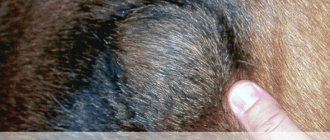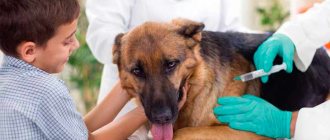For what reasons can a dog vomit white foam?
Don't panic if your dog vomits white foam once. The appearance of the discharge does not indicate illness; it is a physiological reaction to food entering the colon. The stomach remains empty, and mucus accumulates in the intestines. It contains proteins and mucopolysaccharides, which begin to foam upon contact with oxygen. Vomiting is the body’s way of cleansing itself of accumulated secretions and maintaining the integrity of the organ.
There are several physiological causes of white foam:
- This is a way to get rid of excess food or a foreign body that has been eaten (accompanied by a cough).
- The foamy substance is formed from saliva that constantly flows. The phenomenon is inherent in dogs with a certain muzzle shape: mastiffs, bulldogs, boxers.
- Some pets have sensitive digestion, and changing their diet leads to the appearance of a symptom (Yorkshire terriers more often suffer from the problem).
- Belching is the result of a long break between feedings; excess gastric juice has accumulated.
- Motion sickness and severe fright lead to the accumulation of foamy saliva in the corners of the mouth.
- Nausea after vaccination (without fever, appears once).
- The dog eats grass, it comes out with white foam. This is a normal process of cleansing the body and is necessary for animals.
If vomiting is repeated many times, while other symptoms are observed, we can talk about pathological problems:
- Vomiting foam and diarrhea with blood in a dog are symptoms of helminth infection. Appetite remains or increases, but the animal loses weight.
- Intoxication of the body with poisons - body temperature decreases, the individual refuses to eat, stool upset is observed, pupils dilate, convulsions are possible.
- Poisoning. The pet does not eat, only drinks water. Any food causes nausea.
- Epileptic seizure. The pet falls over on its side, convulses, and foams at the mouth continuously. The bowels and bladder are emptied unconsciously. Labradors, spaniels, poodles and Great Danes are at risk.
- Intestinal plague is an infection characterized by purulent conjunctivitis, photophobia, and lack of appetite. After a few days, the temperature rises, the stool may be liquid or accompanied by constipation. Dehydration quickly sets in.
- Rabies is one of the most dangerous diseases. Characteristic signs are that the dog constantly vomits white foam, the lower jaw is paralyzed, and a fear of water appears.
- If an animal vomits foam with blood, we can talk about damage to internal organs (usually due to injury from an inedible object or bone). Also, blood streaks may indicate stomatitis (you need to check the mouth and the integrity of the mucous membranes).
- The symptom is accompanied by a sweetish odor - there is a possibility of developing diabetes.
- A putrid odor indicates gastrointestinal diseases.
- Kidney pathologies are characterized by vomiting and the “aroma” of ammonia.
- If a dog vomits mucus and foam (white, brown, yellow or gray), it is necessary to check the dog for diseases such as hepatitis, gastritis, and oncology of internal organs.
When should you go to the vet?
Medications for treatment are not prescribed independently. The only exception applies to adsorbents. If white foam comes out once, then it is considered a natural process. Thus, the dog gets rid of foreign bodies. When the condition worsens, action must be taken. First aid is provided at home before visiting the clinic.
Veterinarian help is needed:
- In case of an epileptic seizure, a visit to the doctor is mandatory. After the necessary tests, medications will be prescribed to restore the central nervous system.
- If there is a suspicion that your dog has rabies, you should not delay the appointment. The animal must be isolated and, if possible, a veterinarian must be called to the home.
- To administer IV drips intravenously or under the withers, you cannot do without a visit to the hospital. The solutions will help restore water-salt balance, avoid dehydration and relieve intoxication.
- If parasites or blood are found on the white foam, you should immediately show the animal to a doctor. At the appointment, the necessary medications will be selected after examination and diagnosis.
- Diseases caused by the virus are treated with antibiotics and related medications. The dosage is calculated depending on the infection and the weight of the animal.
The physiological process does not require intervention. The animal should be monitored. The pathological condition, depending on the disease, occurs in different ways. The period for full recovery may vary. It is important to notice the problem in time and begin treatment. When properly prescribed, the disease goes away without complications for the animal. To normalize the functioning of the intestines and digestive tract, medications are prescribed after intoxication has been removed. It is necessary to provide the animal with proper care and nutrition. In order to avoid problems, preventive measures are taken. It is important that the dog receives adequate nutrition. Physical activity in the fresh air will strengthen your immune system. A healthy dog will only bring joy to its owner.
If a dog vomits white foam several times a day, this indicates the beginning of a pathological process. Often this symptom is a harbinger of severe infectious diseases, damage to the digestive system. In order for the dog to recover faster, it is necessary to find out the possible causes of vomiting and provide first aid to the pet.
How to provide first aid to a pet?
The possibility of treatment at home depends on the causes of the problem. If the vomiting was sporadic, without diarrhea, the dog feels well and reacts to external stimuli, limit yourself to observation. Think about what caused the nausea, perhaps:
- The periods between feedings are too long, shorten the break or increase the nutritional value of the portion.
- Mild poisoning can be cured independently with the help of absorbents (activated carbon, enterosgel).
- If your pet is coughing, gagging, foaming at the mouth, or choking. If necessary, help your dog get rid of the stuck object.
- Epilepsy attack. Your help is to prevent injury to the animal. Lay him on his side, support his head, remove potentially dangerous objects. After the convulsions stop, contact your veterinarian.
- In case of loss of consciousness, it is necessary to lay the dog on its side, open its mouth slightly so that the vomit can easily come out.
If a pregnant dog vomits, then we are not talking about pathology, but about toxicosis. Like people, pets suffer from it in the first half of pregnancy, especially in the morning. Do not force feed the animal, try to show more attention and care, increasing the amount of vegetables in the diet will benefit.
If you suspect dehydration while you are waiting for medical attention, fill a syringe without a needle with warm boiled water with added sugar. Introduce the contents into the mouth in small portions. Do not try to feed the dog, this will make the situation worse.
When your dog vomits bile with foam or exhibits other warning signs, seek medical attention immediately. As part of first aid, you can only keep the animal calm and offer water. You cannot carry out any treatment yourself; it is dangerous for the pet’s life.
Provide the animal with a calm environment. Do not scold him under any circumstances; the urge to vomit is uncontrollable.
What to do: take it to the vet or treat it yourself
To prevent further absorption of toxic substances, after vomiting, the animal should be given activated carbon or other adsorbents to drink. The owner’s actions should depend on the cause of the pathology:
- A small amount of white foam accumulating at the corners of the mouth indicates exhaustion. In this case, the owner can handle it on his own. It is necessary to review your pet's diet and reduce the time between feedings.
- If there are worms in the foam, you should seek help from a veterinarian. The doctor will prescribe anthelmintic drugs depending on the body weight and age of the pet.
- In case of stomatitis or oral trauma, which can lead to the formation of white foam, it is worth examining the animal's mouth. When the mucous membranes of the oral cavity are affected, the dog coughs up blood. It is necessary to remove foreign bodies from the wounds and treat them with a disinfectant solution. With the development of a purulent-inflammatory process, the dog will need antibiotics and special ointments for wound healing. They must be prescribed by a veterinarian.
- During an epileptic seizure, you need to place the dog on its side, slightly holding its head above the floor. When the dog coughs up, you need to tilt his mouth down a little to facilitate the passage of vomit. The animal's body may be shaken by convulsions, so it is necessary to free the space from foreign objects. The dog can get hurt on them. After the attack passes, you need to take the dog to the veterinary clinic, where the pet will be prescribed anticonvulsant drugs.
- If the dog is poisoned, you need to give the dog adsorbents and give enemas. To prevent dehydration, it is recommended to call a veterinarian at home. The specialist will put in a drip with saline solution.
- If you suspect rabies, you must isolate your pet, call a veterinarian, or take it yourself to a clinic for euthanasia.
- Plague is caused by pathogenic microorganisms - Yersinia. To eliminate them, antibiotics and immunostimulants are needed. Treatment should be carried out by a veterinarian. You can give your dog multivitamin complexes on its own.
First aid
Before visiting a veterinary clinic, you should monitor your pet’s condition and take pre-medical care:
- Let the dog lick the ice.
- If the condition improves and the vomiting stops, you can give your pet chicken broth. The next day, if the dynamics of recovery are positive, you should give the animal fresh food in liquid form: puree poultry meat in a blender with the addition of herbs and boiled rice. It is allowed to switch to a normal diet for 3-4 days.
- If the condition worsens and the dog refuses to drink or eat, it is necessary to urgently take the pet to the veterinarian. The doctor will prescribe tests, x-rays, ultrasound and cardiogram. Instrumental and laboratory tests will help evaluate the functioning of internal organs, exclude the development of allergies and check for the presence of cancerous tumors.
Drug therapy
If nausea and foamy vomiting occurs in the veterinary clinic, the dog is given injections of sodium chloride intramuscularly or subcutaneously to restore water and electrolyte balance. After this, a diagnosis is carried out and, depending on the data obtained, therapy with the following drugs is prescribed:
- Papaverine or No-shpa to relieve stomach cramps and pain;
- Cerucal, necessary to stabilize the vomiting center in the brain;
- Omez to reduce the acidity of gastric juice;
- Enterosgel, which allows you to speed up the removal of poison from the body.
Treatment with drugs should be carried out by the attending physician. Self-therapy can lead to a deterioration in the animal’s general condition and increases the risk of death. In parallel with taking medications, the veterinarian prescribes a gentle diet. Correcting the diet will help normalize the functioning of the digestive system and reduce the load on organs that are weakened due to intoxication.
Feeding and drinking regime
The pet owner needs to remember what his pet has eaten recently. This information can help determine the cause of vomiting. Before visiting the veterinarian, it is not recommended to feed your pet, so as not to accidentally provoke new discharge of white foam. The doctor should carry out the diagnosis on an empty stomach.
If the vomiting has stopped and the visit to the veterinary clinic is cancelled, you should also not give the dog food. Fasting for a day will help remove all toxins from the body and cleanse the gastrointestinal tract. During this period, you should give your pet boiled water to drink in small portions. After 24 hours, you are allowed to gradually return to your normal diet.
To begin with, it is recommended to give the animal chicken broth. After this, you need to monitor the dog’s well-being for 2 hours. If the dog is in a good mood, you can give him boiled rice or buckwheat. At the same time, 5-6 times a day you need to give the sick pet a decoction based on peppermint and flaxseeds. During the first week of rehabilitation, you need to give the animal food 5-6 times a day every 2-3 hours in small portions. The amount of food must be increased gradually. Thanks to this approach, it is possible to reduce the load on the digestive organs and normalize the process of absorption of nutrients.
Further treatment
Therapy depends on what the examination shows. Several directions can be distinguished:
- Vomiting of white foam and diarrhea in a dog indicate poisoning; it can be treated with diet and absorbents such as Smecta and activated carbon. An enema or gastric lavage is prescribed.
- Papaverine is used to relieve spasms and relieve pain symptoms. Among antispasmodics, No-shpu and Cerucal are also used.
- The formation of stomach acid in gastrointestinal diseases is reduced by Omeza, and tissue inflammation is also reduced.
- If worms are found in the foam or stool, treat with anthelmintic drugs.
- Infectious diseases are treated with antibiotics and IVs; it is important to prevent the infection from spreading.
- In case of severe anxiety, the list of medications is supplemented with sedatives.
- If tumors or foreign bodies stuck in the intestines are detected, surgery is recommended.
- Plague is treated with antibiotics and antiviral drugs, and therapy is supplemented with immunomodulators and complex vitamins.
- Treatment of epilepsy largely depends on its type. Anticonvulsants and second-generation antiepileptic drugs are most often prescribed. They drink away the course. In some cases, surgical intervention is indicated.
The only incurable disease characterized by white foam is rabies. The virus is dangerous for both animals and people, so if the diagnosis is confirmed, the pet must be euthanized.
Prevention
To avoid unpleasant consequences, it is necessary to prevent the disease in time. The main preventative measure is constant care, regular feeding and attention to pets. In addition, you should adhere to the following recommendations:
- Puppies need to train their vestibular apparatus. To do this, you can pick up your pet and often take it with you on short trips.
- Dogs should not be allowed to eat foreign food on the street or lick garbage or excrement of other animals. You need to make sure that your dog doesn’t accidentally swallow a sharp object while walking. Large dogs should be muzzled when walking. It will help protect your pet from swallowing foreign bodies and toxic substances.
- Monitor foods in your dog's diet. You cannot suddenly change the food or introduce a new product into the diet in large quantities. Food must be carefully checked for freshness.
- Aerosols against lice and fleas should be hidden on the top shelves or in cabinets so that the dog cannot get them and chew them. Detergents and other toxic compounds should be stored in drawers with a handle.
Dogs must be promptly vaccinated at a certified veterinary clinic and dewormed.
Feeding mode
Once your pet's condition has stabilized, it is important to follow feeding recommendations. This will allow you not to overload your stomach and quickly get into the normal rhythm of life. After poisoning, fasting for a day is enough to completely cleanse the body. During this period, boiled or bottled water is given in small sips.
Then you can start complementary feeding. Food is offered in small portions; chicken or turkey fillet puree is best; you can add a small amount of greens or zucchini. A good option is a light poultry broth. Treats and bones are prohibited during recovery. Gradually introduce cooked food, semi-liquid cereals, small pieces of meat.
Other feeding recommendations depend on the type of problem. If the dog eats dry food, then the veterinarian should select a special line for pets with gastrointestinal diseases and sensitive digestion.
Video: what to do if your dog is vomiting white foam? Treatment at home
Diseases of dogs accompanied by vomiting
There are quite a lot of diseases accompanied by vomiting and release of gastric contents in dogs. First of all, these include problems with the gastrointestinal tract. In addition to these problems, vomiting may be accompanied by the following diseases:
- infectious;
- internal non-infectious;
- parasitic.
A common pathology in dogs is megaesophagus - dilation of the esophagus, accompanied by impaired peristalsis. As a rule, the disease is congenital in nature, affects the thoracic part of the esophagus, and is characterized by regurgitation of food that has stagnated in the esophagus. Usually, owners mistake regurgitation for vomiting and believe that the dog is vomiting food. In fact, the food regurgitated by a dog has practically no traces of digestion or exposure to gastric juice. Such a lump often has an elongated shape. To confirm megoesophagus, an X-ray examination with a contrast agent is performed. Indirect data can be obtained by checking the acidity of the contents - with megoesophagus, the acidity of the food coma will be low.
There are many infectious diseases in dogs that are accompanied by vomiting. The most dangerous of them include:
- carnivore plague;
- infectious hepatitis;
- parvovirus enteritis;
- leptospirosis;
- colibacillosis.
With the development of these diseases, the dog’s gastrointestinal tract, kidneys and liver are affected. Involvement of the liver and gallbladder in the process is characterized by the appearance of yellow vomiting in dogs, damage to the gastrointestinal mucosa is caused by impurities in the vomited blood contents. Yellow or greenish liquid released during vomiting may indicate the presence of a large amount of bile in the stomach and indicate improper functioning of the gallbladder or bile ducts.
Vomiting in dogs is often accompanied by helminthic infestation. In this case, the dog may experience vomiting on an empty stomach; the vomit contents are whitish or yellow, sometimes in the form of foam. The contents often contain fragments of helminths.
An almost obligatory sign in dogs is vomiting in case of poisoning; the appearance of reddish or yellow foam is often observed.
Poisoning occurs when eating missing food, pickled baits, poisoned dead rodents, or aggressive substances. The stomach contents may look completely different depending on the dose and type of poison the dog ingested. In the case of poisoning in a dog, the outcome depends on the urgency and correctness of the measures taken to evacuate the contents of the gastrointestinal tract, detoxify the body, and use specific antidotes.
You need to carefully monitor your pet's health. Any deviation in behavior and well-being requires immediate action. The symptom of vomiting white foam in a dog often frightens owners. You should understand the reasons, features of the process, and also study the rules of first aid.
Prevention of gastrointestinal problems in dogs
It is better to prevent problems, so prevention of gastrointestinal diseases is important. It is divided into two areas: care and education. Here are some practical recommendations:
- Monitor the animal's diet. Food should be suitable and fresh, avoid sudden changes in diet.
- Prohibit picking up small pieces of food on the street or from the floor, or rummaging through trash cans. There is a high risk of choking on a foreign body, getting injured by a bone, or eating a stale or toxic product.
- If the dog does not obey and grabs everything edible on the street, put a muzzle on it.
- Every 3-4 months carry out prophylaxis against worms.
- Get a rabies vaccination every year.
- Be careful when using household chemicals and medications. The dog should not have access to them.
- Get used to transportation gradually; if the animal is very sick, transport it on an empty stomach.
And the main means of prevention is attentiveness. Observe your pet, its appetite and well-being; most often, the dog’s changed behavior indicates a developing problem. Carry out preventive examinations; timeliness is an excellent weapon in the fight against diseases.
Periodic vomiting should not be a cause for concern; it is one of the protective mechanisms of the animal body. But if the phenomenon is accompanied by other alarming symptoms and continues for several days, there is no need to postpone a visit to the doctor.
What not to do
It is strictly forbidden to scold the dog or use physical violence as punishment if the dog soils the furniture or carpet while vomiting. During this period, the animal recovers from shock and experiences severe stress. The pathological condition can provoke an attack of aggression. In the worst case scenario, the dog will stop trusting its owner.
It is important to remember that the animal does not control the gag reflex. Along with semi-digested food, toxic substances and swallowed objects are removed from his body. This will help alleviate the dog's condition.
If your pet clears its throat, do not hit it on the back or sides. Strong impacts can damage the ribs. Such manipulations will not help the dog, because animals have a different body structure.
IMPORTANT. If an attack of vomiting occurs during a walk, you must immediately remove the narrow collar or muzzle from the dog. This is necessary so that the animal does not choke on the food masses.
Danger of vomiting
Being a symptom of various pathological processes occurring in the dog’s body, vomiting itself, however, can cause significant damage to the animal’s health. The main danger of vomiting is dehydration. The water entering the stomach does not have time to be absorbed and comes out along with the vomit. Dehydration develops especially quickly when diarrhea occurs. Uncontrollable vomiting, combined with diarrhea, can lead to the death of a dog in a fairly short time.
Insufficient fluid intake, its loss through vomiting, leads to a decrease in the volume of blood in the bloodstream. This condition is called hypovolemia. Hypovolemia is especially dangerous for organs sensitive to oxygen starvation. First of all, these include:
- brain;
- kidneys;
- pancreas.
Severe vomiting can be compared to bleeding in its effect on the body. The only difference is that when bleeding, the volume of blood decreases physically, and when vomiting, the liquid part of the blood decreases. Hypovolemia leads to severe, often irreversible consequences associated with the death of cells in sensitive organs. In this case, the dog may experience symptoms of central nervous system damage, acute renal failure, pancreatitis, etc.
In addition, blood thickening leads to the development of a high load on the cardiovascular system. The heart, forced to increase its contraction rate to compensate for the lack of oxygen in the tissues, must push viscous blood through the vessels with greater force. Blood thickening greatly increases the risk of thrombosis.
Preventive actions
You can give your dog buckwheat porridge.
Compliance with preventive measures can help prevent relapse. It is important to provide your pet with regular and balanced nutrition. After surgery or long, difficult treatment, the animal needs to be given high-quality dietary food. Abrupt changes in nutrition are not allowed.
It is not recommended to feed your pet “natural food”.
The exceptions are buckwheat and rice porridge . You need to be careful with oatmeal, as large amounts can cause stomach upset.
From puppyhood, you need to teach your dog not to pick up trash on the street. But you shouldn't stop her from eating grass. Often the animal cleanses its stomach in this way.
Causes
The formation of white foam is a natural process. It occurs as a result of the interaction of mucus, oxygen, and gastric juice. With the help of spasms, the foamy mixture is pushed out.
In the case where a dog vomits once, the vomiting is physiological in nature. There is usually no need to see a doctor.
Main reasons:
- The animal independently tries to get rid of the foreign body. Wool caught in the stomach and small objects eaten are harmful to health. It's better when everything comes out naturally.
- The dog regurgitates the foamy contents when he is very hungry. A lot of gastric juice is produced during the day. If it is not used to digest food, then vomiting occurs.
- Severe stress for a dog provokes nausea. The pet experiences changes in the environment and conditions of care. The animal often gets sick while traveling by car.
- Due to the structure of the digestive tract, white foam vomiting is common in small breeds. The dog's body immediately reacts to changes in the food offered.
- Breeds that salivate excessively produce mucus that can be mistaken for vomit. This occurs due to the structural features of the jaws.
Diseases that cause vomiting
Nausea becomes a sign of illness when the pet's behavior changes. The animal refuses food, is less active, whines, and hides. In addition to this, the dog burps several times a day. To establish the correct diagnosis, you should immediately contact a veterinary clinic. In rare cases, the cost of providing assistance runs into hours.
List of diseases:
- Poisoning from food and chemicals. There is a change in stool, lethargy and refusal to eat. In difficult cases - convulsions.
- Diseases of the digestive system provoke vomiting and diarrhea with blood. These include: gastritis, cholecystitis, intestinal obstruction. The animal feels pain in the abdomen and reacts sharply to touch.
- Rabies is a deadly disease for both dog and owner. Symptoms of the disease are fear of water, paralysis of the respiratory tract, and aggressive behavior.
- Infectious infection occurs with elevated temperature and deterioration of the pet’s condition. Hepatitis and plague lead to depletion of the body and require immediate treatment.
- White foam is a sign of worms. Pests attack the internal organs of the animal and lead to nausea. Appetite usually increases, but weight loss continues.
- Epileptic seizures are accompanied by discharge from the mouth. Seizures occur most often in poodles, labradors and spaniels.
- Heatstroke triggers the gag reflex. The animal may lose consciousness for a short period of time.
- Kidney failure is accompanied by a pungent odor of ammonia from the mouth. Diseases of the genitourinary system require medication.










